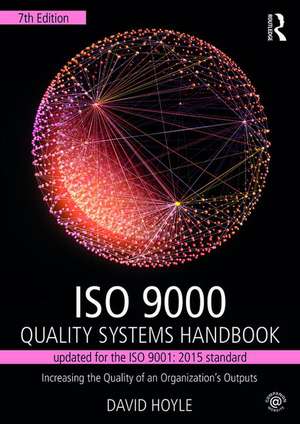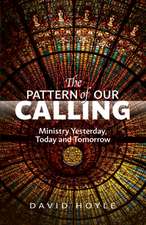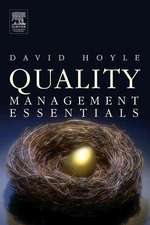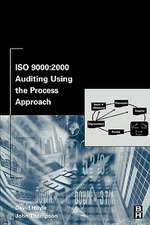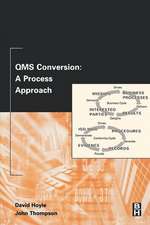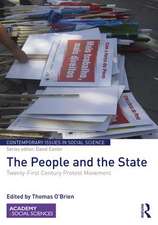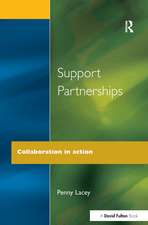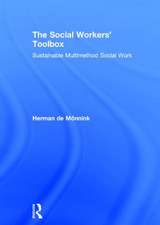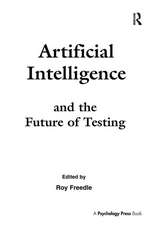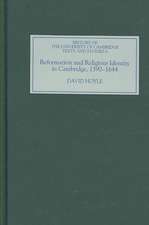ISO 9000 Quality Systems Handbook-updated for the ISO 9001: 2015 standard: Increasing the Quality of an Organization’s Outputs
Autor David Hoyleen Limba Engleză Paperback – 10 iul 2017
Whether you are an experienced professional, a novice, or a quality management student or researcher, this is a crucial addition to your bookshelf. The various ways in which requirements are interpreted and applied are discussed using published definitions, reasoned arguments and practical examples. Packed with insights into how the standard has been used, misused and misunderstood, ISO 9000 Quality Systems Handbook will help you to decide if ISO 9001 certification is right for your company and will gently guide you through the terminology, requirements and implementation of practices to enhance performance.
Matched to the revised structure of the 2015 standard, with clause numbers included for ease of reference, the book also includes:
- Graphics and text boxes to illustrate concepts, and points of contention;
- Explanations between the differences of the 2008 and 2015 versions of ISO 9001;
- Examples of misconceptions, inconsistencies and other anomalies;
- Solutions provided for manufacturing and service sectors.
Don’t waste time trying to achieve certification without this tried and trusted guide to improving your business – let David Hoyle lead you towards a better way of thinking about quality and its management and see the difference it can make to your processes and profits!
Preț: 448.73 lei
Preț vechi: 487.75 lei
-8% Nou
Puncte Express: 673
Preț estimativ în valută:
85.87€ • 93.25$ • 72.13£
85.87€ • 93.25$ • 72.13£
Carte disponibilă
Livrare economică 01-15 aprilie
Livrare express 15-21 martie pentru 66.12 lei
Preluare comenzi: 021 569.72.76
Specificații
ISBN-13: 9781138188648
ISBN-10: 1138188646
Pagini: 892
Ilustrații: 44 Tables, black and white; 101 Illustrations, black and white
Dimensiuni: 174 x 246 x 51 mm
Greutate: 1.45 kg
Ediția:7 ed
Editura: Taylor & Francis
Colecția Routledge
Locul publicării:Oxford, United Kingdom
ISBN-10: 1138188646
Pagini: 892
Ilustrații: 44 Tables, black and white; 101 Illustrations, black and white
Dimensiuni: 174 x 246 x 51 mm
Greutate: 1.45 kg
Ediția:7 ed
Editura: Taylor & Francis
Colecția Routledge
Locul publicării:Oxford, United Kingdom
Public țintă
Professional Practice & DevelopmentNotă biografică
David Hoyle as a manager, consultant, author and mentor has been helping individuals and organizations across the world understand and apply ISO 9001 effectively since its inception in 1987. He has held senior positions in quality management with British Aerospace and Ferranti International and worked with such companies as General Motors, the UK Civil Aviation Authority and Bell Atlantic on their quality improvement programmes. Although neither a member of ISO nor BSI technical committees, he has been a member of the CQI for over 40 years and through his work with them built a network of like-minded professionals including members of ISO and BSI technical committees, which gave him privileged access to many reports, presentations and early drafts and thus gained an insight into the thinking behind ISO 9001:2015.
Recenzii
David Hoyle's latest work on this ISO 9000 Handbook once again "cracks the code", encrypted by the ISO TC 176 authors and offers, actionable, pragmatic advice for users and quality practitioners around the World on how to understand and effect the ISO 9000 family of documents. With so many competing publications on the subject, this 7th edition should be the essential, go-to handbook for quality professionals seeking to understand and benefit from an ISO 9001 modeled quality system.
Sidney Vianna, Management System Professional, DNV GL, USA.
A must-have for anyone tasked with facilitating the creation and delivery of value to stakeholders, David Hoyle's staggeringly powerful latest edition of Quality Systems Handbook expertly and thoroughly demystifies the updated ISO 9000 Standards. An indispensable tool for managing quality and successful Certification.
John Colebrook, Director, Enhanced Operating Systems Ltd, New Zealand.
A valuable resource that explores salient concepts arising from the ISO 9001:2015 standard in an unambiguous manner. David Hoyle using his inimitable step by step approach demonstrates the applicability of quality management standard to any organisational context.This book is definitely recommended reading for both academics and business leaders seeking to gain an in depth understanding of quality management systems.
Dr Lowellyne James, Lecturer in Quality Management, Robert Gordon University, IEMA Certificate in Sustainability Strategy Programme Leader, Scotland.
To be up-to-date with the latest in ISO 9000 Quality Systems (ISO9000:2015), this is the definitive guide to refer to. David Hoyle’s 7th edition stays true to its purpose of ensuring interpreting the Standard, comprehensible.
Christopher Seow, Visiting Lecturer "Six Sigma for Managers" Cass Business School, City, University of London, UK.
David Hoyle pulls no punches in this very comprehensive seventh edition of his ISO 9000 Handbook. Whether you are a scholar, business executive, quality manager, consultant or a Certification Body, this book is for you. He goes out of his way to change the misconception of what the ISO 9001:2015 standard is really all about. He meticulously explains that it is aimed at improved performance and not just a set of requirements for compliance. David convinces the reader that Quality should be managed as an integral part of every business.
Paul Harding, Managing Director, South African Quality Institute, South Africa.
Yet again David Hoyle has produced another excellent book that explains the new standard and its requirements in straightforward terms. It is the book we have all been waiting for that will help us implement the new Standard and will become the new bible for quality management Systems. If you follow the advice in Hoyle’s book you will not have any issues when the auditor arrives at your door. It is suitable for all people involved in the standard from company directors who need to know more about their responsibilities to experienced and busy Quality Managers who need to implement and inform others about the changes.
Rhian Newton, HSEQ Manager, Morgan Advanced Materials, UK.
The book does a great job of showing how a quality system built to the principles of ISO 9000 and conforming to the new ISO 9001:2015 requirements can be an integral part of leadership's strategic approach to running the business versus letting a quality management system operate in a silo.
The book explores and explains the ISO9001:2015 requirements in a way that is easy to follow yet at the same time deep and meaningful especially for those new concepts and requirements such as leadership, context of the organization and managing risk. This feels like a book I'll keep referring to for many years to come.
Richard Allan, Director, Quality Assurance, Kimberly-Clark Corporation, UK.
Sidney Vianna, Management System Professional, DNV GL, USA.
A must-have for anyone tasked with facilitating the creation and delivery of value to stakeholders, David Hoyle's staggeringly powerful latest edition of Quality Systems Handbook expertly and thoroughly demystifies the updated ISO 9000 Standards. An indispensable tool for managing quality and successful Certification.
John Colebrook, Director, Enhanced Operating Systems Ltd, New Zealand.
A valuable resource that explores salient concepts arising from the ISO 9001:2015 standard in an unambiguous manner. David Hoyle using his inimitable step by step approach demonstrates the applicability of quality management standard to any organisational context.This book is definitely recommended reading for both academics and business leaders seeking to gain an in depth understanding of quality management systems.
Dr Lowellyne James, Lecturer in Quality Management, Robert Gordon University, IEMA Certificate in Sustainability Strategy Programme Leader, Scotland.
To be up-to-date with the latest in ISO 9000 Quality Systems (ISO9000:2015), this is the definitive guide to refer to. David Hoyle’s 7th edition stays true to its purpose of ensuring interpreting the Standard, comprehensible.
Christopher Seow, Visiting Lecturer "Six Sigma for Managers" Cass Business School, City, University of London, UK.
David Hoyle pulls no punches in this very comprehensive seventh edition of his ISO 9000 Handbook. Whether you are a scholar, business executive, quality manager, consultant or a Certification Body, this book is for you. He goes out of his way to change the misconception of what the ISO 9001:2015 standard is really all about. He meticulously explains that it is aimed at improved performance and not just a set of requirements for compliance. David convinces the reader that Quality should be managed as an integral part of every business.
Paul Harding, Managing Director, South African Quality Institute, South Africa.
Yet again David Hoyle has produced another excellent book that explains the new standard and its requirements in straightforward terms. It is the book we have all been waiting for that will help us implement the new Standard and will become the new bible for quality management Systems. If you follow the advice in Hoyle’s book you will not have any issues when the auditor arrives at your door. It is suitable for all people involved in the standard from company directors who need to know more about their responsibilities to experienced and busy Quality Managers who need to implement and inform others about the changes.
Rhian Newton, HSEQ Manager, Morgan Advanced Materials, UK.
The book does a great job of showing how a quality system built to the principles of ISO 9000 and conforming to the new ISO 9001:2015 requirements can be an integral part of leadership's strategic approach to running the business versus letting a quality management system operate in a silo.
The book explores and explains the ISO9001:2015 requirements in a way that is easy to follow yet at the same time deep and meaningful especially for those new concepts and requirements such as leadership, context of the organization and managing risk. This feels like a book I'll keep referring to for many years to come.
Richard Allan, Director, Quality Assurance, Kimberly-Clark Corporation, UK.
Cuprins
Contents
Preface to the Seventh Edition
Part 1 Introduction
Chapter 1 Putting ISO 9001 in context
Chapter 2 Comparison between 2008 and 2015 editions
Chapter 3 How the 2015 version has changed misconceptions
Key messages from Part 1
Part 2 Anatomy and use of the standards
Chapter 4 The ISO 9000 family of standards
Chapter 5 A practical guide to using these standards
Key messages from part 2
Part 3 Terminology
Chapter 6 Quality
Chapter 7 Requirements
Chapter 8 Management System
Chapter 9 Process and the process approach
Chapter 10 Risk and opportunity
Chapter 11 Interested parties and stakeholders
Key messages from Part 3
Part 4 Context of the organization
Chapter 12 Understanding the organization and its context
Chapter 13 Understanding the needs and expectations of interested parties
Chapter 14 Scope of the quality management system
Chapter 15 Quality management system
Chapter 16 Processes needed for the QMS
Key messages from Part 4
Part 5 Leadership
Chapter 17 Leadership and commitment
Chapter 18 Customer focus
Chapter 19 Policy
Chapter 20 Organizational roles, responsibilities and authorities
Key messages from Part 5
Part 6 Planning
Chapter 21 Actions to address risks and opportunities
Chapter 22 Quality objectives and planning to achieve them
Chapter 23 Planning of changes
Key messages from Part 6
Part 7 Support
Chapter 24 People
Chapter 25 Infrastructure
Chapter 26 Environment for the operation of processes
Chapter 27 Monitoring and measuring resources
Chapter 28 Organizational knowledge
Chapter 29 Competence
Chapter 30 Awareness
Chapter 31 Communication
Chapter 32 Documented information
Key messages from Part 7
Part 8 Operation
Chapter 33 Operational planning and control
Chapter 34 Customer communication
Chapter 35 Requirements for products and services
Chapter 36 Review of requirements for products and services
Chapter 37 Design and development planning
Chapter 38 Design and development inputs
Chapter 39 Design and development controls
Chapter 40 Design and development outputs
Chapter 41 Design and development changes
Chapter 42 Control of externally provided processes, products and services
Chapter 43 Evaluation, selection and monitoring of external providers
Chapter 44 Information for external providers
Chapter 45 Control of production and service provision
Chapter 46 Identification and traceability
Chapter 47 Property belonging to external providers
Chapter 48 Preservation of process outputs
Chapter 49 Control of changes
Chapter 50 Release, delivery and post-delivery of products and services
Chapter 51 Control of nonconforming outputs
Key messages from Part 8
Part 9 Performance evaluation
Chapter 52 Monitoring, measurement, analysis and evaluation
Chapter 53 Customer satisfaction
Chapter 54 Analysis and evaluation
Chapter 55 Internal audit
Chapter 56 Management review
Key messages from Part 9
Part 10 Improvement
Chapter 57 Determining and selecting opportunities for improvement
Chapter 58 Nonconformity and corrective action
Chapter 59 Continual improvement of the QMS
Key messages from Part 10
Appendices
A Common Acronyms
B Glossary of terms
Index
Preface to the Seventh Edition
Part 1 Introduction
Chapter 1 Putting ISO 9001 in context
Chapter 2 Comparison between 2008 and 2015 editions
Chapter 3 How the 2015 version has changed misconceptions
Key messages from Part 1
Part 2 Anatomy and use of the standards
Chapter 4 The ISO 9000 family of standards
Chapter 5 A practical guide to using these standards
Key messages from part 2
Part 3 Terminology
Chapter 6 Quality
Chapter 7 Requirements
Chapter 8 Management System
Chapter 9 Process and the process approach
Chapter 10 Risk and opportunity
Chapter 11 Interested parties and stakeholders
Key messages from Part 3
Part 4 Context of the organization
Chapter 12 Understanding the organization and its context
Chapter 13 Understanding the needs and expectations of interested parties
Chapter 14 Scope of the quality management system
Chapter 15 Quality management system
Chapter 16 Processes needed for the QMS
Key messages from Part 4
Part 5 Leadership
Chapter 17 Leadership and commitment
Chapter 18 Customer focus
Chapter 19 Policy
Chapter 20 Organizational roles, responsibilities and authorities
Key messages from Part 5
Part 6 Planning
Chapter 21 Actions to address risks and opportunities
Chapter 22 Quality objectives and planning to achieve them
Chapter 23 Planning of changes
Key messages from Part 6
Part 7 Support
Chapter 24 People
Chapter 25 Infrastructure
Chapter 26 Environment for the operation of processes
Chapter 27 Monitoring and measuring resources
Chapter 28 Organizational knowledge
Chapter 29 Competence
Chapter 30 Awareness
Chapter 31 Communication
Chapter 32 Documented information
Key messages from Part 7
Part 8 Operation
Chapter 33 Operational planning and control
Chapter 34 Customer communication
Chapter 35 Requirements for products and services
Chapter 36 Review of requirements for products and services
Chapter 37 Design and development planning
Chapter 38 Design and development inputs
Chapter 39 Design and development controls
Chapter 40 Design and development outputs
Chapter 41 Design and development changes
Chapter 42 Control of externally provided processes, products and services
Chapter 43 Evaluation, selection and monitoring of external providers
Chapter 44 Information for external providers
Chapter 45 Control of production and service provision
Chapter 46 Identification and traceability
Chapter 47 Property belonging to external providers
Chapter 48 Preservation of process outputs
Chapter 49 Control of changes
Chapter 50 Release, delivery and post-delivery of products and services
Chapter 51 Control of nonconforming outputs
Key messages from Part 8
Part 9 Performance evaluation
Chapter 52 Monitoring, measurement, analysis and evaluation
Chapter 53 Customer satisfaction
Chapter 54 Analysis and evaluation
Chapter 55 Internal audit
Chapter 56 Management review
Key messages from Part 9
Part 10 Improvement
Chapter 57 Determining and selecting opportunities for improvement
Chapter 58 Nonconformity and corrective action
Chapter 59 Continual improvement of the QMS
Key messages from Part 10
Appendices
A Common Acronyms
B Glossary of terms
Index
Descriere
Packed with insights into how the standard has been used, misused and misunderstood, ISO 9000 Quality Systems Handbook will help you to decide if ISO 9001 certification is right for your company and gently guide you through the terminology, requirements and implementation of practices to enhance performance.
